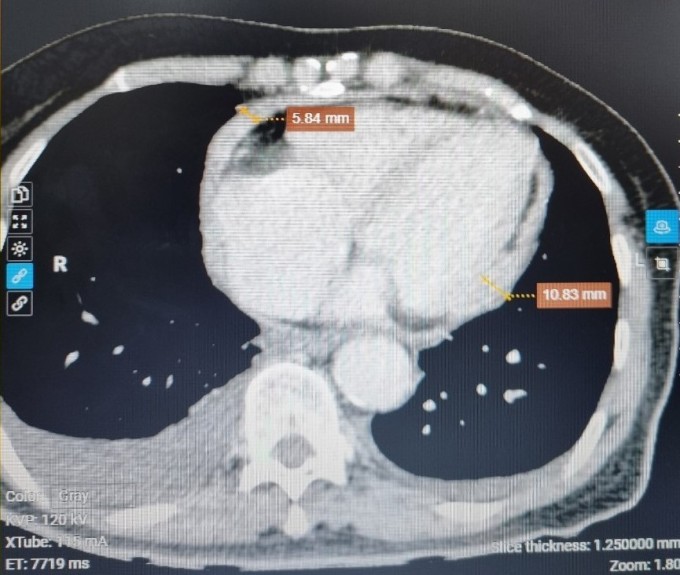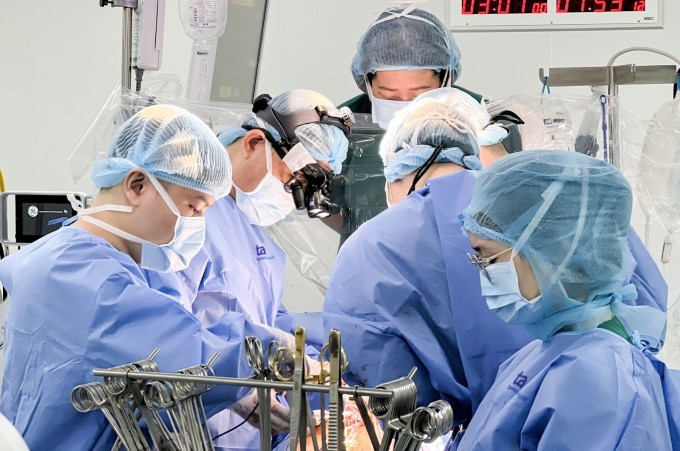Ho Chi Minh City , Ms. Mien, 71 years old, was infected with tuberculosis leading to inflammation and fibrosis of the pericardium but did not know, thinking she had pneumonia.
Ms. Mien had a fever, cough, fatigue, and poor appetite two months ago. She went to a hospital and was diagnosed with pneumonia and was hospitalized for two weeks. In early November, she had a fever again, was tired, had more difficulty breathing, and lost a lot of weight. She went to Tam Anh General Hospital in Ho Chi Minh City for examination.
On December 13, Dr. Hoang Thi Binh, Deputy Head of the Cardiology Department, Cardiovascular Center, said that the patient had respiratory failure, a lot of pericardial and pleural effusion, and an enlarged liver, suspected to be due to respiratory disease. The doctor drained the lung fluid, but 2-3 days later the fluid filled up again, and the test for tuberculosis bacteria was negative.
A week later, the cause of her condition was still unknown, and treatment was only aimed at improving symptoms. Several lung aspiration tests showed that the fluid might be related to heart failure (different from the fluid usually associated with cancer or infection). At this time, the doctor ordered an echocardiogram, which revealed heart failure (EF, which measures the heart's pumping function, was 50%, compared to more than 50% in normal people).
An MRI scan revealed a thickened pericardium, nearly 11 mm in some places (normal pericardium is only about 2-3 mm). The doctor concluded that she had constrictive pericarditis - a condition that occurs when the pericardium loses its elasticity, becomes scarred, and becomes a hard shell that tightly wraps around the heart. As a result, the heart struggles to pump enough blood to meet the body's needs, leading to heart failure over time. In addition, blood returning to the heart is difficult, causing stagnation, causing an enlarged liver and pleural effusion.

Image of thickened pericardium, the thickest part up to 11 mm on cardiac MRI. Photo: Tam Anh Hospital
Dr. Nguyen Anh Dung, Head of the Department of Cardiovascular and Thoracic Surgery, Cardiovascular Center, and the surgical team performed a pericardial stripping surgery combined with a pericardial biopsy. The results showed that the agent causing constrictive pericarditis was tuberculosis bacteria. After entering the body, tuberculosis bacteria will travel to nearby lymph nodes and into the blood to all organs. In this case, tuberculosis bacteria attacked the heart, causing Ms. Mien to have difficulty breathing, fatigue, and pleural effusion for the past few months.
One day after the surgery, the patient's shortness of breath decreased, heart failure improved, and there was no more pleural effusion. The patient continued to be treated with a tuberculosis regimen to completely eradicate the bacteria causing the disease.
Three weeks after surgery to remove the pericardium caused by tuberculosis bacteria, Mrs. Mien's health has stabilized, no longer tired or short of breath. She eats well, sleeps well and has gained 2 kg. Her EF index has increased to 56%, no longer has pericardial effusion or pleural effusion.

Doctor Dung (second from left) and the surgical team removed the thick pericardium layer from the patient. Photo: Tam Anh Hospital
Dr. Binh said that constrictive pericarditis starts slowly and is difficult to detect. Doctors often think of other causes of fatigue and shortness of breath, such as heart failure, coronary artery disease, liver disease, or other gastrointestinal diseases. As in Ms. Mien's case, initially she suspected lung disease, then discovered constrictive pericarditis.
There are many causes of constrictive pericarditis such as chest trauma; autoimmune diseases or inflammatory disorders such as lupus, rheumatoid arthritis, Sjögren's syndrome; complications of heart surgery; cancer radiation therapy; metastatic cancer... Of which, 20-30% of pericarditis cases are related to tuberculosis.
According to Dr. Binh, there is currently no way to prevent constrictive pericarditis. Patients can reduce the risk of developing this condition by promptly treating bacterial infections, limiting radiation damage to the pericardium during radiation therapy, and avoiding situations that could cause chest trauma.
Thu Ha
* Patient name has been changed
| Readers ask questions about cardiovascular disease here for doctors to answer |
Source link




























![[Photo] National Assembly Chairman Tran Thanh Man visits Vietnamese Heroic Mother Ta Thi Tran](https://vphoto.vietnam.vn/thumb/1200x675/vietnam/resource/IMAGE/2025/7/20/765c0bd057dd44ad83ab89fe0255b783)











































































Comment (0)